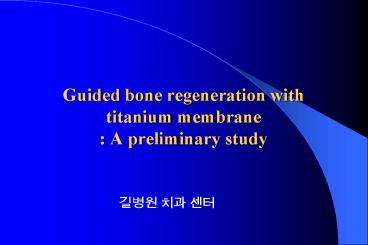Guided bone regeneration with titanium membrane : A preliminary study - PowerPoint PPT Presentation
1 / 31
Title:
Guided bone regeneration with titanium membrane : A preliminary study
Description:
Title: Guided bone regeneration with titanium membrane : A preliminary study Author: Last modified by: Created Date: 4/21/2002 8:46:09 AM – PowerPoint PPT presentation
Number of Views:1764
Avg rating:3.0/5.0
Title: Guided bone regeneration with titanium membrane : A preliminary study
1
Guided bone regeneration with titanium membrane
A preliminary study
- ??? ?? ??
2
Introduction
- Sufficient volume quality of alveolar bone
- Esthetics function in implant dentistry
3
Guided tissue regeneration
- The use of membranes to guide bony tissue
formation by separating the underlying bone from
the overlying connective tissue - by creating a space into which the desirable
bone cells can migrate -
- by Dahlin C. 1994
4
Indication of GBR
- Extraction site
- - Prevention of crestal bone loss
- especially when 1 or more wall missing
- Correction of inadequate ridge width or shape
- - Atrophic alveolar bone reconstruction for
implant - placement
5
Indication of GBR
- Dehicence defects
- Apical fenestration
- Residual intraosseous defects
- - Fresh or incompletely repaired extraction
site
6
Historical review of GBR
- Regeneration of alveolar bone beneath cellulose
acetate filler implant -
- by Boyne PJ. 1964 - Healing of bone defects by GTR
- - by
Dahlin C et al. 1988
7
Historical review of GBR
- Bone formation utilizing titanium-reinforced
barrier membrane -
- by Jovanovic. 1995 - Augmentation of intramembraneous bone beyond the
skeletal envelope using an occlusive titanium
barrier -
- by Lundgren D. 1995
8
Basic mechanism of GBR
- Prevention of fibroblasts filling the defect
- Prevention of contact inhibition by heterotophic
cell interaction - Exclusion of cell-derived soluble inhibitory
factors
9
Requirement of GBR barrier membrane
- Biocompatibility safety
- Cell occlusiveness
- Space-making ability
- Tissue integration
- Clinical manageability cost effectiveness
-
- by Teparat T et al. 1998
10
Consideration of selecting membrane
- The creation maintenance of sufficient space
underneath the barrier is an important factor for
a successful results
11
Classification of barrier membrane
- Nonresorbable membrane
- Resorbable membrane
12
Nonresorbable membrane
- Expanded polytetrafluoroethlene ( e-PTFE )
- - Goretex
- Nonexpanded polytetrafluoroethlene
- - Tef Gen-FD
13
Nonresorbable membrane
- Titanium-reinforced expanded
- polytetrafluoroethlene
- Titanium membrane with microperforation
- - FRIOS Bone shield
14
Resorbable membrane
- Collagen barriers
- - Bio-Guide, Bio-Mend, Colla Tape
- Synthetic polymers
- - Vicryl Mesh, Resolut, Resolut XT
15
Resorbable membrane
- Biologically active membrane
- Platelet-rich plasma
- Other barrier materials
- - Capset, Lambone
16
Characteristics of titanium membrane
- Mechanical property of rigidity
- Smooth titanium surface with laserbeam-derived
microperforation - Lateral marginal slit for fixation shaping
17
(No Transcript)
18
Advantage of titanium membrane
- Effective fixation of grafting materials
- Optimal mechanical stability
- Easy durable shaping
- Maximum biocompatibility
- Easier fixation by membrane tacks
19
Disadvantage of titanium membrane
- Increase in the number of exposure with mucosal
perforation - Refrain from the placement of intermediate
dentures - Technical sensitivity
20
Purpose
- The purpose of this preliminary study is to
present clinical results of titanium membrane
used for GBR in implant dentistry
21
Patients
- Patients 6 patients ( Since 2000.11 )
- Sex Male ( 4 ), Female ( 2 )
- Age 16-42years
22
Results
No Sex Age Procedures Location Time of exposure Membrane maintenance Complication management
1 M 39 12 Ridge splitting - 7 mths -
2 M 33 22 Lab. dehiscence 3 wks 3 wks Local infection Osseointegration failure
3 F 42 32-41 Lab. dehiscence 2 mths 2 mths -
23
Results
No Sex Age Procedures Location Time of exposure Membrane maintenance Complication management
4 M 33 11-21 Ridge splitting 4 mths 4 mths Lab. fistula bone destruction Curettage with TC powder Mx tuberosity bone graft
5 F 16 36 Lab Lig dehiscence 4 wks 8 wks Osseointegration failure Remarks) Graft material good embedded state
6 M 42 14 Lab. dehiscence - 5 mths -
24
Results
- 2 Patients Uneventful healing of GBR site
retrieval of membrane after adequate healing
period - 4 Patients Membrane exposures after primary
healing of mucosal incision
25
Consideration of selecting membrane
- Most flexible membranes do not have enough
rigidity tend to collapse - More rigid nonresorbable membrane is needed
26
(No Transcript)
27
(No Transcript)
28
(No Transcript)
29
(No Transcript)
30
Discussion
- The time between operation exposure of the
membrane is critical point - The rigidity of the titanium membrane leads to an
increase in the number of exposure
31
Conclusion
- The rigidity of titanium membrane makes the
barrier able to maintain space - Careful soft tissue management avoid directing
loading by intermediate denture is essential to
prevent wound dehiscence































